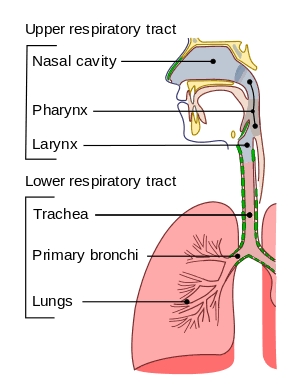
UPPER RESPIRATORY TRACT INFECTION
Know about Upper Respiratory Tract Infection :
- What is Upper Respiratory Tract Infections (URTI’s)?
These are common viral infections caused by the invasion of viruses in the mucosal layer affecting the nose, throat and airways.
- What does Upper Respiratory Tract include?
It includes sinuses, nasal passages, pharynx and larynx.
- What is the span of URTI’s?
It resolves within 7-10 days.
- What are the symptoms of URTI’s?
Symptoms last for 3-14 days if it gets longer than that, then diagnosis for sinusitis (cavities around nasal passages become inflamed), allergy, pneumonia (infection that inflames air sacs in one or both lungs which may fill with fluid) or bronchitis (inflammation in the lining of bronchial tubes) should be done.
URTI symptoms includes:
- Cough (from laryngeal swelling and nasal drip)
- Sneezing
- Odynophagia (painful swallowing)
- Nasal discharge
- Nasal congestion
- Malaise (feeling of being slightly ill)
- Low grade fever
- Foul breath
- Rhinorrhoea (runny nose)
- Headache and conjunctivitis (itchy and watery eye)
- Shortness of breath
- Sinus pain
- Scratchy / sore throat
5. What are the examples of URTI’s?
- Rhinitis – Inflammation of nasal cavity
- Sinus infection – Inflammation of the sinus located around the nose.
- Nasopharyngitis (common cold) – Inflammation of nares (nostrils), pharynx, hypopharynx, uvula and tonsils.
- Pharyngitis – Inflammation of pharynx, uvula and tonsils.
- Epiglottitis – Inflammation of the upper portion of larynx and epiglottis.
- Laryngitis –Inflammation of larynx
- Laryngotracheitis – Inflammation of larynx and trachea.
- Tracheitis – Inflammation of trachea.
6. How does URTI spread?
Four stages of spreading :-
1. Incubation Stage : It typically takes 1 to 3 days. Symptoms develop after 10 to 12 hours of exposure to viruses.
2. Symptoms take Peak : It mainly includes sore throat, stuffy nose, runny nose, cough, discomfort, sneezing, fever, headaches, body aches.
3. Symptoms Fade : After 3 to 10 days mucus discharge changes to a white, yellow or green color. Antibiotics are still not needed.
4. Beyond 10 Days : Remaining symptoms can last upto 2 weeks.
7. What is the role of the Immune System in URTI?
Adenoids and tonsils have immune cells that respond to pathogens. Humoral immunity (immunoglobulin A) and cellular immunity with the help of recruited macrophages, monocytes, neutrophils and eosinophils engulf and destroy invaders.
8. What treatment is given to patients having URTI’s?
- Oral fluids for rehydration
- Honey
- Salt water gurgles
- Acetaminophen/ paracetamol (for red fever and body aches)
- Nonsteroidal anti-inflammatory drugs like ibuprofen
- Antihistamines like diphenhydramine, cetirizine, levocetirizine, chlorophenamine, loratadine (decrease nasal secretion and congestion)
- Productive cough medication like deriphyllin
- Decongestants like pseudoephedrine, phenylephrine (high blood pressure patients can’t take this)
- Broad spectrum antibiotics are used.
“URTIs are self-limiting and can be spread by droplets”.
If you want to submit your work Contact US
For more information Visit our Site






